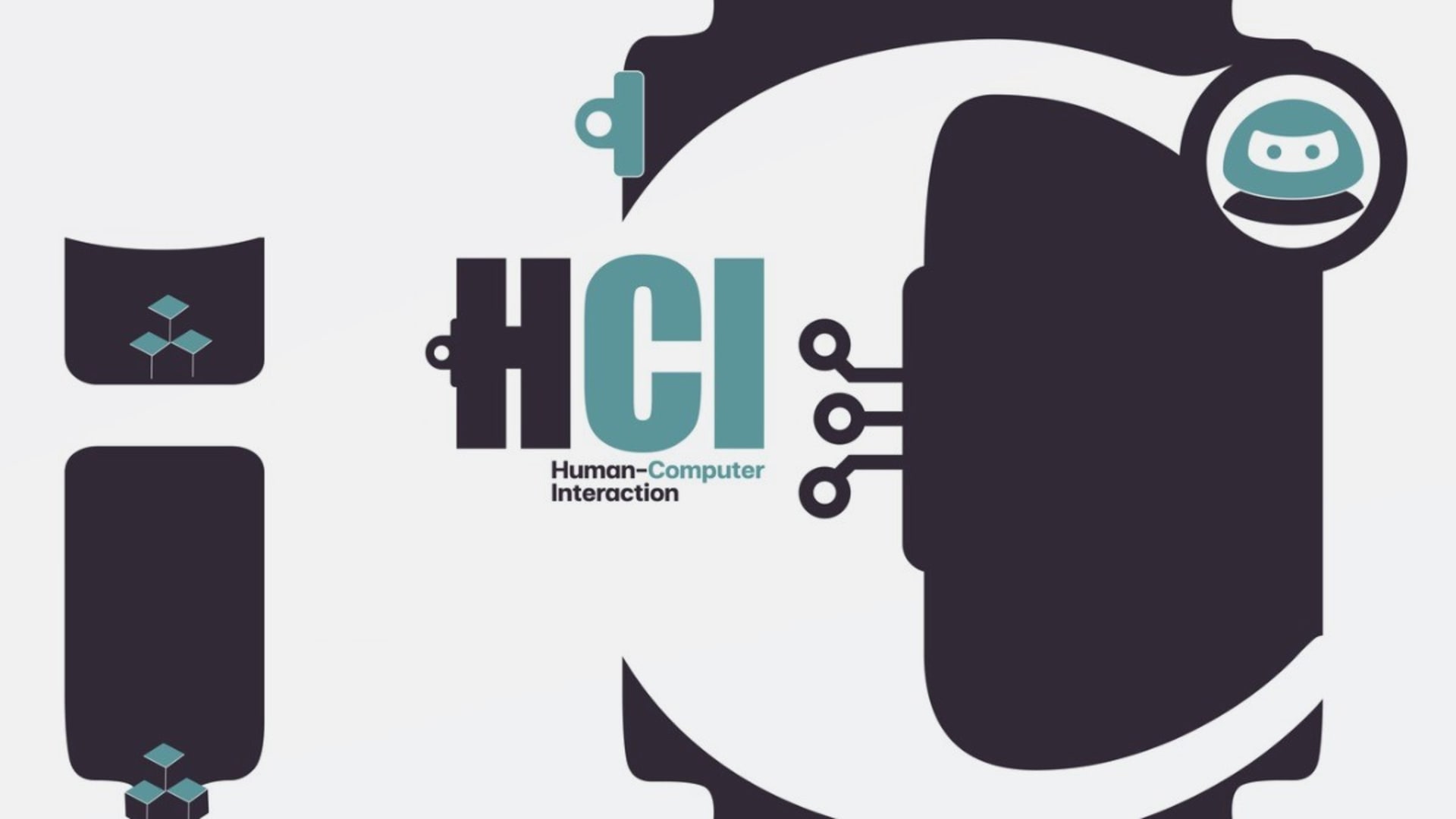A field blending aspects of cognitive science, computer science, and human factors in engineering, the study of Human-Computer Interaction (HCI) focuses on the interactions of human beings with computer systems. By studying how users interact with machines and vice versa, professionals create more intuitive, accessible, and interactive computer interfaces driven by how humans choose to connect with technological devices.
What Is HCI?
The field of Human-Computer Interaction studies the intricate relationship between users and computers to enhance the design of the computer interface. This dynamic discipline uses ideas and principles from various domains such as ergonomics, graphic design, psychology, behavioral science, and computer science.
The research concerning the field aims to enhance the interaction between humans and computers by considering the intended users’ abilities, desires, needs, perceptions, preferences, and physical limitations.
Why Is Human-Computer Interaction Important?
Businesses want to build technology that users actually want to use. The only way to accomplish this is to learn what users deem usable and helpful through research and testing. By studying Human-Computer Interaction as it applies to a given projects, teams build more user-minded technology with natural, intuitive graphical user interfaces for users of all ability levels, knowledge bases, and areas of expertise backed by research.
Generally, HCI aims to make using technology more straightforward and natural to keep users happy while bringing them back for more. Through careful design and usability testing, developers identify and probe areas for user errors and potential frustration to create a hassle-free product. HCI helps increase productivity by reducing the level of effort needed and the overall cognitive load of a product.
By emphasizing safety, HCI helps ensure that critical computer systems always prioritize usability in technologies like industrial equipment and medical devices, along with desktop computers, mobile devices, and more.
In addition to ensuring safer experiences, this research field helps users make more informed decisions by transforming highly complex data and concepts into insights users actually understand and can take action with. Overall, researching and understanding HCI helps give companies a competitive advantage by allowing them to create more user-friendly products and services that users actually want to use and rely on.
History and Evolution of HCI
Personal computing initiated the HCI revolution. It first appeared as a field in the 1980s, as personal computers became more common in homes and offices. As they became more ubiquitous, these devices became smaller and less expensive. There was also a greater emphasis on accessibility and efficiency in human-computer interactions.
Human-computer interaction researchers needed a way to allow the interactions between humans and computers to resemble those between two humans as much as possible with open-ended dialogue. HCI experts initially focused on word processors, numerical units, and video games. Over time, the field evolved to encompass the design, implementation, and evaluation of interactive interfaces. The areas of user experience and user interface design utilize principles of this field as well.
Components of HCI Technology
HCI technology focuses on four main components to make up a whole experience: the user, the tools, the interaction styles, and the tasks.
#1 Users
Users are the main focus of all HCI research because the field uses their preferences, characteristics, and behaviors to build and interaction design systems and interfaces. The field analyzes human emotions, experiences, and cognitive capabilities while also studying their goals, needs, and interaction styles to build ideal technology for the targeted users. Users benefit from better experiences when interacting with systems and devices.
Understanding User Characteristics
HCI research takes many aspects and qualities of users into consideration, most notably their demographic traits, cognitive and physical attributes, and learning styles. An excellent example of why these characteristics are important is that the younger user base may value a product that offers more efficiency while older users find it more important for the product to offer greater precision. Designers and researchers must understand their target users’ characteristics and wants in order to create a successful product.
User Roles in HCI
This field includes various roles for each project. The end-users offer invaluable feedback for design teams when creating a new product or service or improving an existing system. Stakeholders also play a significant role in HCI because they are the people or entities with an influence on design decisions. For instance, they determine the suitable types of end users or demographics instead of simply creating a system for generic user bases.
User Personas and Scenarios
Designers working with HCI research strive to avoid making decisions based on assumptions. However, they don’t always have access to enough resources and test users to accomplish their goals. Design teams commonly leverage user personas to avoid this problem. Although they don’t describe real people, user personas take on the attributes of prospective users to help designers understand human patterns and perspectives when making crucial decisions.
#2 Tasks
The series of actions users must go through to achieve a specific goal within a device or computer system are called tasks. These are the tools or steps that help users reach their intended goals. By analyzing tasks, designers gain a more profound understanding of the path to create more intuitive interfaces with consideration of the complexity, skills required, and time needs.
Task Analysis
Researchers observe users while they perform tasks to assess an issues they encounter and to create a task flow with a solution to these problems. Hierarchical task analysis, for instance, breaks tasks down into smaller steps as a structured, systematic approach. This process also allows designers to identify critical, redundant, or problematic steps.
Goals vs. Tasks
A goal is what the user wants to achieve by using a system’s set of tasks in a particular order, while a task is the series of actions required to reach or achieve the goal.
Task Complexity and Frequency
Duration, frequency, and complexity are parts of task analysis that directly influence designers’ priorities. Designers should optimize the most frequently used tasks, simplify the most complex, and break down longer tasks into subtasks.
#3 Tools
Tools are the interfaces that connect human interactions with computers and systems, including both hardware and software components.
Software Tools in HCI
The study of HCi utilizes various software tools including specification methods, interface-building tools, interface mockup tools, grammar and spelling tools, and evaluation tools to create, maintain, and support programs.
Hardware Tools in HCI
Hardware tools are the items that users physically touch or utilize to interact with systems like the keyboard, monitor, and mouse. Applying researched principles from HCI creates more comfortable and ergonomic alternatives to the standard hardware options for improved accessibility.
Newer hardware types include touchscreens, speech recognition systems, and virtual and augmented reality tools. Haptic feedback allows devices to use motors and sensors to create responses to the user via exoskeleton devices, vibrotactile technology, or skin indentation devices. This hardware is a popular part of the gaming industry.
Interaction Styles
Interaction styles in HCI refer to how users communicate with or otherwise interact with computers and systems. These styles include:
- Command language or entry: Experts utilize command prompts by typing in commands and parameters to dictate the execution of the command.
- Form fill-in: Allows typically non-expert users to fill in a form-based interface based on pre-defined form fields.
- Menu selection: Users choose from a set of predefined menu options where the selection/execution of each option changes the interface.
- Direct manipulation: Users have visibility of the object of interest and interact with rapid, incremental actions to directly manipulate an object instead of using command language syntax.
- Gesture-based: A newer interaction style, gesture-based interactions happen through human gestures like eye movement, scrolling, pinching, tapping, shaking, and so on to use systems.
Principles of Good HCI Design
The principles of quality HCI design aim to understand human behavior, cognition, and preferences to apply to creating systems and devices. Adhering to these principles helps dev teams and HCI researchers create functional, accessible, and efficient systems for users. To do this, devs must understand how users handle computing systems, use design methods and tools to fit tier needs, and refine products for effectiveness.
Usability and Its Importance
Practical and usable HCI-back systems must have the following usability characteristics:
- Users of all types of skill levels shouldn’t have any problems learning and remembering how to interact with a system.
- Systems should protect users from undesirable situations by preventing mistakes or errors as much as possible.
- Users should enjoy using their computing devices and systems.
- A usable system accomplishes its intended tasks while offering users a high-quality performance throughout the process.
Core Principles of HCI Design
Teams ensure that their technologies are as effective and enjoyable as they are accessible and easy to use by relying on the principles of HCI design.
Consistency
A crucial aspect of HCI is maintaining a uniform design across the entire interface of a system to improve consistency. For instance, visual consistency maintains similar colors, styles, and typography across a system, while functional consistency ensures that similar actions have similar results. The mirroring of real-world conventions in tech also helps improve consistency.
Simplicity
Users want simplicity in technology in most cases. A way to help simplify technology is by prioritizing essential features. The Pareto principle enforces this idea, stating that 80% of consequences come from only 20% of causes. Using more widely-used concepts and universal terms also helps keep tech simple and easy to use.
Feedback
HCI-researched systems offer users feedback regarding their previous actions to help them determine the proper next steps. This immediate, relevant, and clear feedback builds user trust in the company and the product. Progress indications like loaders and progress bars also help users understand where they are in a process or task.
Error Prevention and Recovery
HCI design aims to prevent errors using prevention techniques like tooltip hints, confirmation dialogues, and data validation prompts. Clear error messages like user-friendly and instructive error notifications help bring problems to light. In the event of an error, the design should feature options like undo/redo and “back” functionalities to help users.
Flexibility and Customization
Every user has diverse and unique needs, so systems must accommodate these different demands by offering customization to enhance satisfaction levels. One way to accomplish this is by using an adaptable interface based on user skills or empowering users to change settings, layouts, and themes with more control.
Accessibility
HCI requires designing products for all users, including those with disabilities. To accommodate those with vision problems, for example, designers should ensure text comprehension, while devs should offer extra color blindness considerations like contrast and color controls. Voice and screen readers and keyboard navigation options also help create ways for all users to utilize systems.
Balancing HCI Design Principles
Combining and successfully balancing every HCI design principle into one project is quite a challenge for design teams. While it’s essential to consider and include each principle, doing so without compromising others is tricky. The best way to combat this is by using a cyclic approach to user testing and iterative design where users test and offer feedback on areas they don’t feel pleased with. Designers then create another version of the product to accommodate their feedback.
Methods and Techniques in HCI
Since its inception in the 1980s, HCI research has evolved and continues evolving to accommodate new technologies with evolving research methodologies and data-gathering techniques.
Data Gathering Techniques
HCI researchers have the option to utilize a variety of different techniques for gathering helpful data in their studies.
Observations
Observations are the backbone of any good research study. In HCI research, two important observation methods include ethnography and think-aloud protocols. Ethnography focuses on humans’ use of tools in their everyday lives and their interactions with technology and their surroundings. This research allows designers to understand user behavior and how it affects interaction with an interface. Think-aloud protocols involve observing users interacting with a device or system while encouraging them to say precisely what they think and feel while using it.
Interviews
HCI researchers and designers commonly use interviews to collect direct personal accounts of users’ opinions, perceptions, and experiences. Researchers choose from three types of interviews: structured based on standardized questions, unstructured relying on spontaneity in asking questions about the topic, and semi-structured, combining the two into a more relaxed format.
Surveys
Utilizing surveys in HCI research allows teams to collect large amounts of data from users in a self-reported fashion. Although surveys are less flexible compared to interviews, the two data-gathering methods complement each other. These tools are an excellent way for researchers to get as many perspectives and initial responses as possible to analyze before choosing whom to interview.
Prototyping
Design teams use prototypes to communicate and test their ideas using honest user feedback. Low-fidelity prototypes, such as paper models or sketches, are a great way to generate and explore concepts quickly. High-fidelity prototypes are more for validating specific features and functionalities via interactive mockups and simulations for demonstration.
Examples of HCI
Humans already benefit from the multidisciplinary field of HCI daily as the study influences the computers and devices millions use regularly. However, in addition to the general field of computer science, HCI is also a helpful tool across other industries, like healthcare, entertainment, and transportation.
In Technology
HCI influences today’s technology in a variety of different areas and ways, including:
Wearable User Interfaces
Wearable user devices and Internet of Things systems require and utilize the principles of HCI to ensure that users access products that are easy to control, monitor, and interact with. Implementing these principles allows designers and companies to ensure the intuitive, accessible, and efficient nature of each of their devices.
Virtual and Augmented Reality
As newer and highly immersive technologies, virtual and augmented reality technologies allow users to interact with the digital world in a completely new way. HCI research helps companies create VR and AR technologies by improving product usability, minimizing and mitigating errors, and improving system quality and accuracy. Future applications of both HCI research and AVR/VR include the study of brain-computer interfaces and sentiment analysis.
Voice Assistants
Speech recognition technology interprets commands and performs user tasks. Many standard systems and products like smartphones, chatbots, and virtual assistants already use this techology. When backed by HCI research, these systems better understand commands from humans and respond accordingly with improved accuracy. Voice assistants have the potential to be incorporated into applications such as training sessions, interviews, and enhanced call transcriptions.
In Medicine
HCI already has many applications in the medical field. From mobile apps to health tracking and telemedicine consultations to online patient portals and innovative treatments, tech is a standard part of a medical work nowadays. HCI research helps ensure that the tech in this industry remains user-friendly to improve patient and provider experiences.
Telemedicine
Telemedicine is an easy, convenient way to see a healthcare professional via a computer or smartphone without leaving the house. Remote medical consultations benefit patients by allowing them to stay in the comfort of their own environment and benefit providers by not requiring travel between locations.
Medical Imaging
Healthcare professionals rely on complex software systems to manage electronic health records, medical imaging, and patient monitoring. By using HCI to complement and enhance these systems, the medical field benefits from improved usability, reduced errors, and a more streamlined workflow.
In Entertainment
The entertainment industry aims to immerse and engage audiences with incredible sights, sounds, and experiences. HCI-based systems and research help enhance these experiences even further.
Video Games
HCI in thе gaming industry focuses on еxploring gamеs’ usеr intеrfacеs, mеchanics, and accеssibility and еnhancing thеm to providе a bеttеr usеr еxpеriеncе, incrеasе еngagеmеnt, and ensurе thе satisfaction of gamе еnthusiasts. By applying HCI principlеs, dеsignеrs ensure the accessibility of their interfaces to a broad group of gamеrs, including those with disabilitiеs like motor impairmеnts or color blindnеss.
Streaming Services
Major streaming platforms strive to offer easy-to-use interfaces that allow users to watch their favorite movies, real-time gameplay, and other entertainment by streaming data directly to their devices. Using HCI principles helps experts improve the ease of use of these services as well as accessibility.
Future Trends in HCI
To keep up with the fast-paced technology industry, HCI researchers continuously experiment in the hopes of developing new models of human-computer interactions based on tech advancements and human needs.
Anticipated Developments
The future of the field of HCI features many exciting new developments to benefit both companies and end-users.
Brain-Computer Interfaces
Like something out of a science fiction novel, brain-computer interfaces are new communication systems connecting the brain to an external device. They enable two-way communication between the brain and the device as well. Potential applications for this technology include communication devices, cognitive enhancement technology, assistive technology, and medical apps, as well as gaming and entertainment.
Haptic Feedback Systems
Haptic feedback systems already allow users to experience AR and VR. In the future, this technology will advance further to process various sensations and movements. For example, the Dexta Haptic Gloves, a recent invention, are a pair of gloves that sense and process different sensations, memorize a user’s finger movements while interacting with virtual environments, and then replicate the data across situations.
Augmented Reality and Mixed Reality Interfaces
HCI research will continue empowering the convergence of AR, VR, and artificial intelligence to create innovative mixed-reality interfaces. In these products, elements of each technology seamlessly coexist to create unmatched opportunities for applications across nearly every industry.
Conclusion
Humans interact with technology on a daily basis in a multitude of different ways to enhance everyday life, making human-computer interactions a fundamental part of planning every product. With a deeper understanding of these interactions, designers and developers can build more meaningful, useful products with an emphasis on universal accessibility.
With exciting new technological advancements on the horizon like brain-computer interfaces and mixed reality experiences, the field of HCI must continue to evolve in parallel with technology to meet changing user needs. HCI requires quite a bit of due diligence and research but offers as many benefits to businesses as it does users.







